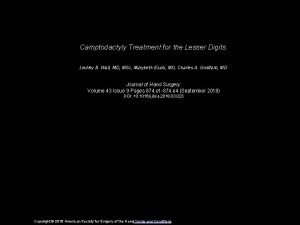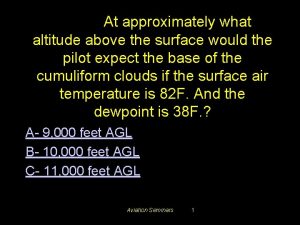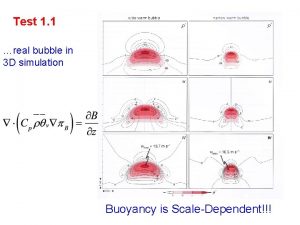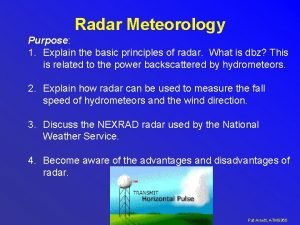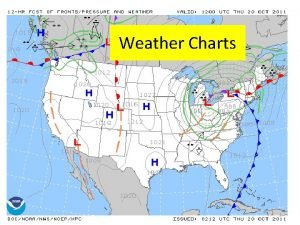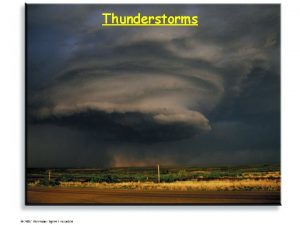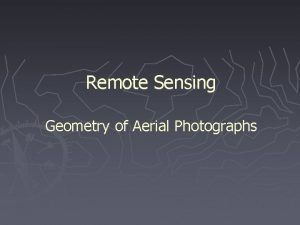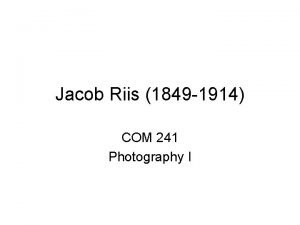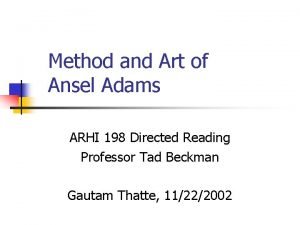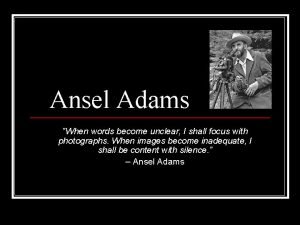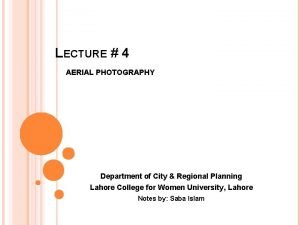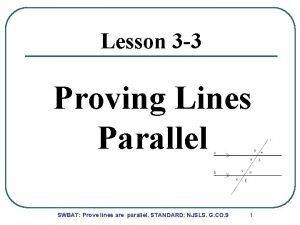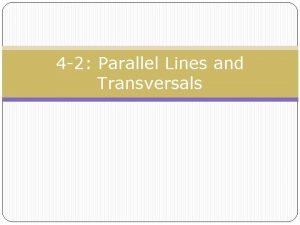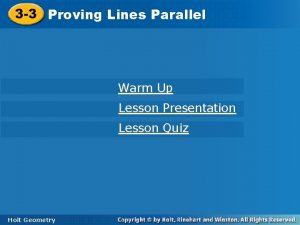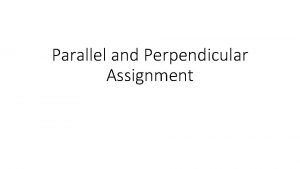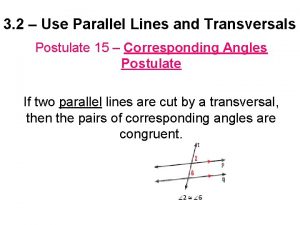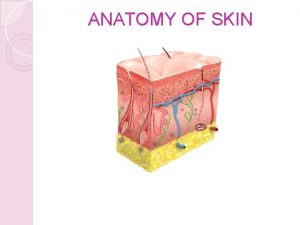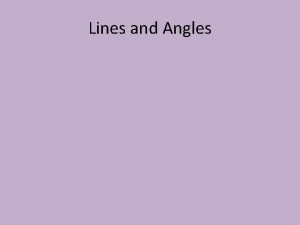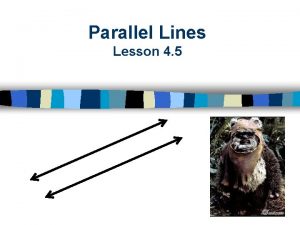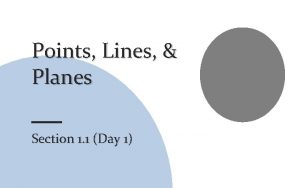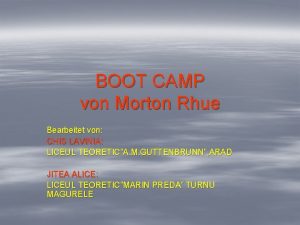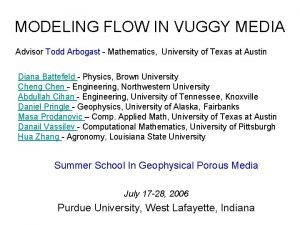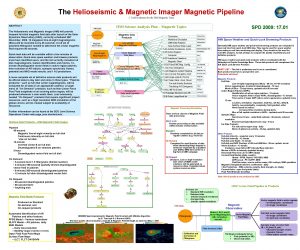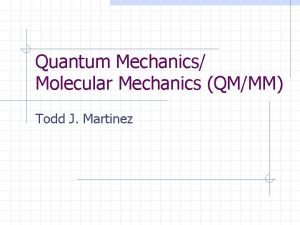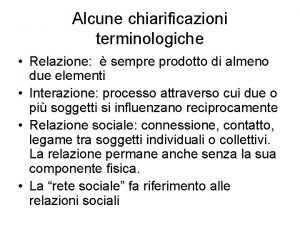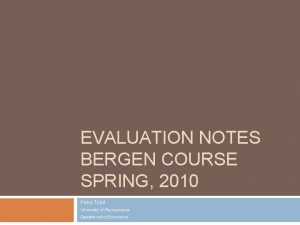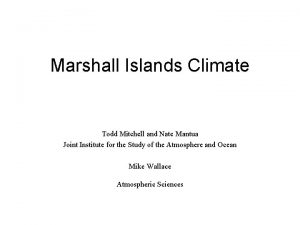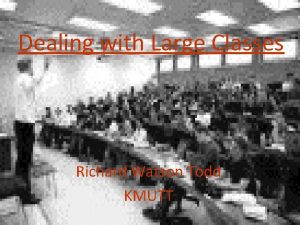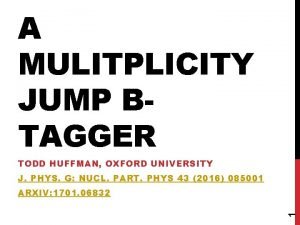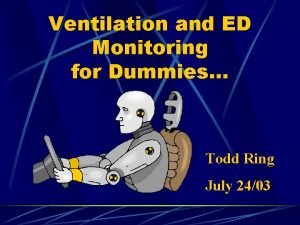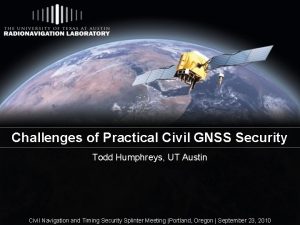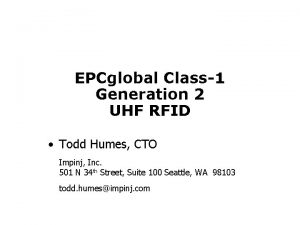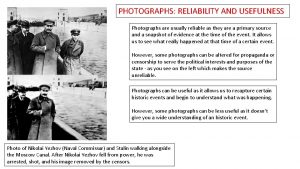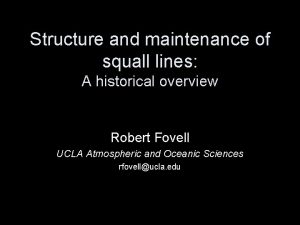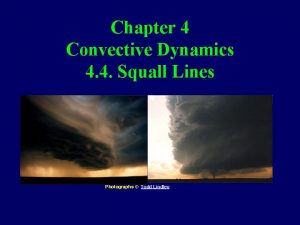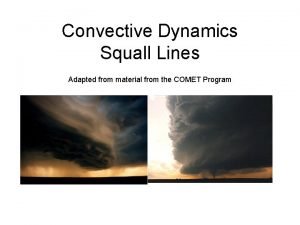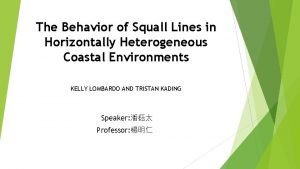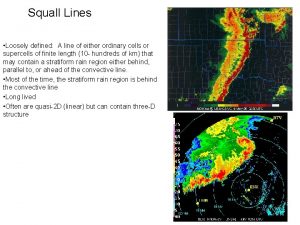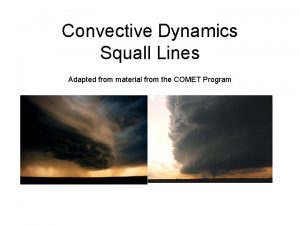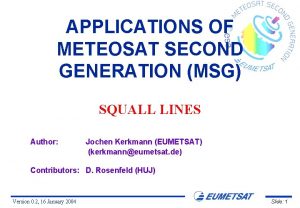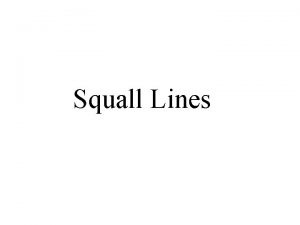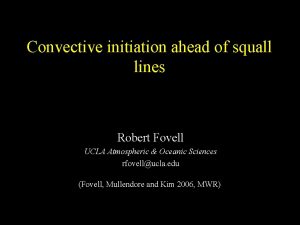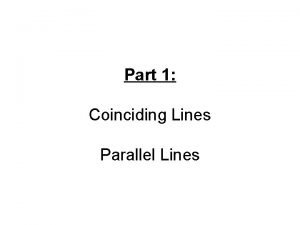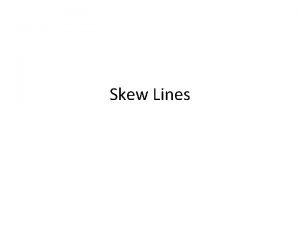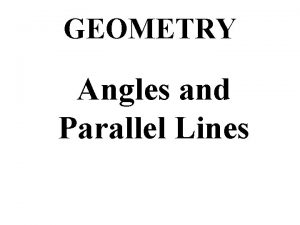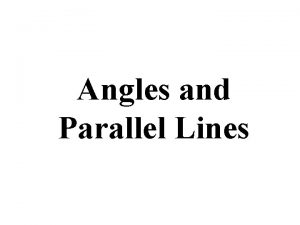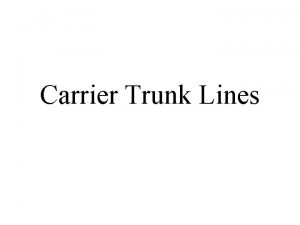Assignment 4 Squall Lines Photographs Todd Lindley Squall

























































































- Slides: 89

Assignment #4


Squall Lines Photographs © Todd Lindley

Squall Lines • We are going to look at – General Characteristics of Squall Lines – organization, structure, weather – Conceptual Models – Theories of Long-lived Squall Lines

Squall Lines – Definition • Squall Line is a type of multicell storm - consist of a line of storms with a continuous, well developed gust front at the leading edge of the line. • These storms can produce small to moderate size hail, occasional flash floods and weak tornadoes.

Squall Lines – Definition • Squall lines are bands of precipitation that are at least partly convective. • Frontal rainbands containing only forced precipitation are not considered squall lines • Squall lines can stretch hundreds or even thousands of kilometers in length and last for many hours. They therefore fall into the category of mesoscale convective system.

2 D and 3 D features of squall lines • Squall lines can often be considered quasi-two-dimensional systems, with the properties of the convective cells and system-scale circulation features quite similar all along the line. Because of this, much can be learned by studying their circulation as viewed in a two-dimensional vertical cross section taken perpendicular to the line. • However, there aspects of squall lines that must be understood in terms of three-dimensional flow features. For instance, when there is sufficient shear to support supercells within the line, each supercellular updraft and downdraft will display significant three-dimensional flow characteristics. Also, mesoscale vortices often form at the ends of a squall line or at breaks within the line. Such mesoscale vortices are critical to the development of severe bow echoes.

Radar View of Squall Lines A primarily 2 D system A system with significant 3 D features

7 May 1995 Squall Line with Trailing Stratiform Precipitation

7 May 1995 Squall Line with Trailing Stratiform Precipitation

A squall line made up of discrete thunderstorms


Formation of Squall Lines • Squall lines form in a variety of ways. They often originate – as a scattered line of convective cells, with new cells eventually filling in the holes in the line, – they also may be triggered as a nearly solid line to begin with. • This latter scenario is especially likely when there is strong large-scale or mesoscale forcing present, as with a cold front or dryline. • In some cases, squall lines are also observed to form from more scattered regions of convective cells or embedded within a more uniform region of stratiform precipitation. • Bluestein and Jain (1985) classified the modes of severe squall line formation in Oklahoma in terms of "broken line*, '' "back building, " "broken areal, " and "embedded areal" cases, with broken line and backbuilding cases representing the most common forms.

Formation of Squall Lines

Dryline


Composite Sound and Hodograph of Squall Line Cases • Squall lines are observed for a wide range of environmental CAPEs and vertical wind shears. However, for a given CAPE, strength and longevity of the system increase with increasing depth and strength of vertical wind shear. • Bluestein and Jain (1985) and Bluestein, Marx, and Jain (1987) characterized the environments of severe versus non-severe squall lines observed in Oklahoma, classified according to the various modes of squall line formation that they identified.

Composite Sound and Hodograph of Squall Line Cases • These studies show that the environments of both severe and non-severe squall lines show significant vertical wind shear, especially at low levels, with the average hodograph oriented about 45 degrees to the line. • The magnitude of the shear on average is slightly stronger for the severe lines than for the non-severe lines. • The average CAPE for the severe lines was significantly larger than for the non-severe lines (2260 J/kg versus 1372 J/kg).

Effects of the Magnitude of Low-level Shear • Once formed, squall lines often display a characteristic lifecycle, starting as a narrow band of intense convective cells and evolving to a broader, weaker system over time. • However, the time over which this evolution takes place and the specific structures that develop within the squall line depend strongly on the magnitude of the low-level vertical wind shear. • In general, weak-shear environments produce squall lines that spread quickly upshear and weaken, while stronger shear environments produce stronger, more long-lived lines composed of strong, leading line convective cells and, perhaps, bow echoes

2 D Evolution of Squall Lines • In presenting the following evolutions, we consider the core region of a squall line, which essentially behaves as a twodimensional system. • For longer lines, this evolution is representative of the majority of the entire system. • We will look at the variations to the basic evolution produced by weak-to-moderate and moderate-to-strong shear environments.

Weak-to-Moderate Shear Case - Early Stage • During the early stages (t=1 -2 h), the system is composed of mostly independent convective cells, each with its own updraft, downdraft, and cold pool. • The line often appears quite narrow, with the surface cold pool generally confined to a small region around the convective cells. • The surface flow field is characterized by system-relative inflow from the east, with diverging flow evident within the cold pool, and resulting strong low-level convergence along the leading edge of the cold pool, especially in the downshear direction (relative to the low-level shear vector).

Weak-to-Moderate Shear Case - Mature Stage • As the squall line matures (t=2 -6 h), it develops a mesoscale organization, characterized by a primarily solid line of strong convective cells at the leading edge, with an extensive surface cold pool extending from the leading edge rearward. • A region of lighter, stratiform precipitation now also extends well to the rear of the leading-line convection. • A narrow region of very light precipitation, referred to as a weak echo channel or transition zone, is often observed between the leading line convection and the stratiform precipitation region. • The wind field at the surface is characterized by diverging flow within the cold pool and strongly converging flow at the leading edge of the cold pool, especially on its downshear side.

Weak-to-Moderate Shear Case - Later Stage • • • During the later stage of the squall line (t=4 -8 h), the leading line convection weakens considerably as the surface cold pool surges well out ahead of the convection. The surface flow features are similar to the mature system, but significantly weaker. Although the convective cells have weakened, the stratiform precipitation region may last for several hours. As the cold pool moves away from the decaying cells, a new line of cells may be triggered as the cold pool weakens, or as the system encounters a more favorable environment. The system may then again take on the characteristics of the mature stage and continue its evolution as before. This process has been observed to lengthen the lifetimes of convective systems considerably. The MCS lifecycle may repeat itself as a new round of convection is triggered at the leading edge of the cold pool, as describe above, or if an external forcing feature, such as a cold front, helps to continually retrigger convection.

Weak-to-Moderate Shear Case - All Stages

Surface Pressure Pattern / Weak-to-Moderate Shear • The surface pressure field during the system’s mature phase reveals many of the classic pressure signatures associated with MCSs, including – a pre-squall mesolow, – a mesohigh in association with the surface cold pool, and – sometimes a distinct wake low at the back edge of the stratiform precipitation.

Vertical Crosssection – early stage • During the initial stages, a vertical cross section through the interior portion of the line depicts the development of an upright to slightly downsheartilted convective cell that evolves through a classic lifecycle similar to that of an ordinary cell. • The flow field is initially characterized by low-level, storm-relative inflow from the east, a strong upright to downshear-tilted updraft, and, finally, an anvil outflow aloft that spreads both westward and eastward, but primarily eastward (given westerly shear). • As the initial cell decays, flow converges into the downdraft at mid-levels from both the front and rear of the system, and then descends and spreads along the surface in the form of a gust front. A new cell is then triggered on the downshear side of the spreading gust front, evolving in a manner similar to the first cell.

Vertical Cross-section – early stage - animation

Vertical Cross-section – mature stage • As the system matures, new cells continue to be triggered along the leading edge of the system. They advect rearward within the system, feeding into an expanding stratiform precipitation region. • The flow field now contains a welldefined upshear-tilted ascending front-to-rear circulation that exits partially forward, but mostly rearward aloft. • In addition, it now exhibits a descending rear-to-front current at mid-levels that diverges both forward and rearward when it reaches the surface, within the cold pool. This flow feature is referred to as the rear-inflow jet.

Vertical Cross-section – mature stage - animation

Vertical Cross-section – later stage • During the later stage, the leading line of convective cells becomes shallower and weaker as the system tilts even more upshear. • The flow field becomes characterized by a much shallower front-to-rear ascending current, with the rear-inflow jet descending and spreading along the surface well behind the leading edge of the cold pool. • The surface cold pool often considerably outruns the precipitation region. • Eventually, the leading line convective cells dissipate completely, leaving behind the stratiform precipitation region.

Vertical Cross-section – later stage - animation

Vertical Cross-section – all stages - animation The complete squall line lifecycle generally takes from as little as 3 -5 h for weak shear cases, to as much as 4 -8 h for moderate shear cases. The full lifetime of the system, however, can often be much longer if a new round of convection is triggered at the leading edge by the weakening cold pool or a more favorable environment, or if an external forcing feature, such as a cold front, helps to continually retrigger convection.

Vertical Cross-section of Pressure Field at Mature Stage / Weak-to-Moderate Shear • A vertical cross section of the pressure field during the mature stage depicts a mesohigh associated with the cold pool at the surface and a mesolow at mid-levels, extending rearward from just above and behind the top of the cold pool. • Also depicted is the pre-squall low and wake low at the surface and a mesohigh at the top of the anvil. • These mesoscale pressure features are essentially in hydrostatic balance, reflecting the integrated effects of warm air and cold air in the atmospheric column above the point of observation.

Severe Weather / Weak-Moderate Shear case • The largest potential for localized severe weather, in the form of hail, localized downbursts, and small tornadoes, is during the early-to-mature phases, when the leading line convective cells are still quite strong. • In moderate shear environments (especially those with high CAPE), large swaths of high winds are most likely during the mature phase, when the system has begun its transition from a vertically erect to an upshear-tilted circulation. This corresponds to the time when a rear-inflow jet is beginning to be generated, with the rear-inflow jet contributing significantly to the strength of the surface winds as it descends to the surface. • Occasionally severe surface winds are also observed at the back edge of the stratiform precipitation region, in association with the surface wake low.

2 D Evolution / Weak-to-Moderate Shear Summary - in plane view • • • At 1 -2 hours into its evolution (early stage), the squall line is composed of independent convective cells and there is low-level convergence along the leading edge of the developing system cold pool At 2 -6 hours into its evolution (mature phase), the squall line has a nearly solid line of strong convective cells at the leading edge, an extensive surface cold pool, a region of enhanced stratiform precipitation separated from the leading cells by a weak echo channel, and strongly converging flow at the leading edge of the cold pool At 4 -8 hours into its evolution (later stage), the squall line's leading edge convection weakens, the surface cold pool surges ahead of the system, the surface flow field weakens, and the stratiform precipitation may last for hours The MCS life cycle may repeat itself as a new round of convection is triggered at the leading edge of the cold pool or if an external forcing feature, such as a cold front, helps to continually retrigger convection The surface pressure field of a mature MCS (evolving in weak-moderate shear) is characterized by a pre-squall mesolow and a mesohigh with the surface cold pool. A wake low may be present at the back edge of the stratiform precipitation In general, the weaker the shear, the faster the evolution

2 D Evolution / Weak-to-Moderate Shear Summary - in vertical cross-section • • • In the early stage, cells may be upright or slightly tilted downshear, whereas the updrafts are tilted downshear. The anvil begins to spread (especially in the downshear direction) The next generation of cell updrafts remain more upright than those of the initial cells In the mature stage, new cells continue to trigger on the leading edge of the cold pool, advect rearward, and feed into the expanding area of enhanced stratiform precipitation The system updraft is now tilted upshear from the front-to-rear of the squall line (the anvil spreads upshear as well), and the rear-inflow jet develops at mid-levels, diverging when it reaches the surface A mature MCS viewed in cross section has a mesolow at mid-levels above the mesohigh with the cold pool, and a mesohigh at the top of the anvil In the later stage, the leading line convective cells become shallower and weaker and the system-scale updraft also becomes more shallow as it tilts further rearward The rear-inflow jet continues to descend and spread out at the surface well behind the leading edge of the cold pool as the gust front considerably outruns the precipitation Localized hail, downbursts, and small tornadoes are most likely during the early-tomature stages, but enhanced system-scale winds associated with the rear-inflow jet are most likely to occur during the mature stage MCSs evolving in large CAPE, moderate low-level shear environments are capable of producing large swaths of damaging winds, usually during their mature stage

Moderate-to-Strong Shear Case - Early Stage • In strongly sheared environments, the evolution of a squall line begins (t=1 -3 h) with an initially narrow line of strong convective cells, with light precipitation often extending downshear (east) of the convective cores. • Some of the cells may be supercellular. • The surface flow field again depicts lowlevel relative inflow from the east, with divergent flow within the cold pool.

Moderate-to-Strong Shear Case - Mature Stage • As the system matures (t=3 -8 h), the relatively narrow line of strong cells persists, with bowshaped segments of cells also beginning to develop as well. • Lighter precipitation begins to extend somewhat rearward (upshear), but to a much less extent than in weaker shears. • The surface gust front maintains its location at the leading edge of the convective cells. • The surface flow field depicts strong convergence at the surface along the leading edge of the gust front, with strong divergence within the cold pool. • The surface pressure field depicts a strong mesohigh collocated with the cold pool.

Moderate-to-Strong Shear Case - Later Stage • During the later stages (t=6 -12 h), leading-line cells become weaker and more scattered along the line, with the region of lighter precipitation extending even further rearward (upshear). • Just as for a weaker shear system, as the cold pool moves away from the decaying cells, a new line of cells may be triggered as the cold pool weakens or as the system encounters a more favorable environment. • The system may then again take on the characteristics of the mature stage and continue its evolution as before. This process has been observed to lengthen the lifetimes of convective systems considerably. • The MCS lifecycle may repeat itself as a new round of convection is triggered at the leading edge of the cold pool, or if an external forcing feature, such as a cold front, helps to continually retrigger convection.

Moderate-to-Strong Shear Case - All Stages

Vertical Cross-section – early stage • Viewed in an east-west vertical cross section, the two-dimensional evolution for strongly sheared squall lines is characterized by a much longer period of downsheartilted structure than weakly sheared lines. • This stage often lasts several hours before the system begins to tilt upshear (if ever). • Individual cells may display extensive echo overhangs on their downshear side.

Vertical Cross-section – early stage - animation

Vertical Cross-section – mature stage • As the system matures, new cells are continually regenerated along the downshear portion of the gust front produced by the older cells. • In a strongly sheared system, these new updrafts still remain strong and vertically erect through mid-levels of the storm. • A rear-inflow jet develops, but in this case it remains more elevated as it approaches the leading edge of the system. • Above the rear-inflow jet, the updraft current turns abruptly rearward (upshear). • Individual strong cells often continue to display extensive echo overhangs on their downshear side. .

Vertical Cross-section – mature stage - animation

Vertical Cross-section – later stage • As the squall line decays, – it begins to tilt upshear, – with the leading-line convective cells weakening and – the rear-inflow jet descending and spreading along the surface further behind the leading edge of the system.

Vertical Cross-section – later stage - animation

Vertical Cross-section – all stages - animation In strongly sheared environments overall system lifetime often extends beyond 12 h, especially if the environment ahead of the system continues to be favorable for convection. External forcing features, such as a cold front, may extend system lifetime even further.

Vertical Cross-section Pressure Pattern / Moderateto-Strong Shear • The pressure field of a strongly sheared squall line in its mature stage depicts a strong mesohigh at the surface and a strong mesolow at mid-levels, above the surface cold pool.

2 D Evolution / Moderate-to-Strong Shear Summary - in plane view • • At 1 -3 hours into its evolution (early stage), the squall line is a narrow line of strong convective cells (some of the cells may be supercellular) and there is strong low-level convergence along the leading edge of the developing system cold pool At 3 -8 hours into its evolution (mature phase), bow-shaped segments may begin to develop. Compared to a weakly sheared system, the stratiform precipitation region is narrower and there is usually no area of enhanced stratiform precipitation The surface flow field is strongly convergent at the leading edge of the cold pool, which remains close to the leading edge of the precipitation At 6 -12 hours into its evolution (later stage), the squall line's leading edge convection begins to weaken, the surface cold pool begins to move ahead of the system, and lighter precipitation begins to fall over a broader area behind the system The MCS lifecycle may repeat itself as a new round of convection is triggered at the leading edge of the cold pool or if an external forcing feature, such as a cold front, helps to continually retrigger convection The surface pressure field of a mature MCS (evolving in moderate-strong shear) is characterized by a pre-squall mesolow and a strong mesohigh with the surface cold pool. A weak wake low is also possible In general, the stronger the shear, the longer this evolution takes. A strongly sheared system may live for > 12 hours, as long as conditions continue to be favorable

2 D Evolution / Moderate-to-Strong Shear Summary - in vertical cross-section • • In the early stage, the system has a much longer period of downshear-tilted structure than weakly sheared systems, and individual cells may display extensive echo overhangs on their downshear side In the mature stage, the updrafts within the new cells being triggered in the downshear direction by the cold pool remain strong and vertically erect through the mid-levels of the storm When the rear-inflow jet develops, it remains more elevated than in weakly sheared systems as it approaches the leading edge of the system. It descends to the surface and creates potentially severe winds A mature MCS in a stronger shear environment has a strong mesolow at mid-levels above the mesohigh with the cold pool and a mesohigh at the top of the anvil In the later stage, the system may finally began to tilt upshear, and the leading line convection begins to weaken The rear-inflow jet continues descending to the surface behind the leading edge of the cold pool, and the gust front begins to outrun the precipitation Hail, strong winds, and tornadoes are possible with any strong cell in the line during the early and mature stages (especially with any supercell), but enhanced system-scale winds associated with the rear-inflow jet and bowing line segments are most likely during the mature stage

Cross-section through a squall line of 21 May 1961 that passed OKC (after Newton 1966)

Conceptual Model Squall Lines with Trailing Stratiform Precipitation (Houze 1989) Overturning branch

Vertical cross section and surface pressure, wind and precipitation distributions during the mature stage of a squall line

Life cycle of a precipitation area associated with a typical squall line

Squall Line 3 D Evolution • The two-dimensional evolution described for the early-to-mature phases of a squall line generally applies to the middle portion of most squall lines. • However, significant threedimensional mesoscale flow features can evolve at the ends of a squall line or at breaks within the line, which can significantly alter the subsequent evolution of the system. • The most prominent of these features is a set of mid-level mesoscale vortices, referred to as "line-end" or "bookend" vortices.

Squall Line 3 D Evolution • Viewing all levels of the storm, the structure of the system during its symmetric phase (early in the evolution) is characterized by low-level divergent flow with the cold pool, symmetric lineend vortices at mid-levels, and the rear-inflow jet concentrated between the vortices. • Aloft, we find divergent flow, with weaker vortices of opposite rotational sense above the mid-level vortices at the northern and southern ends of the system.

Squall Line 3 D Evolution • During the asymmetric phase (later in the evolution), a dominant cyclonic vortex is evident at mid-levels, while both the low-level and upperlevel divergent outflows turn anticyclonically.

Development of Supercell Lines • Most often, squall lines are composed of ordinary cells. • But occasionally, when the environment exhibits strong vertical wind shear at both lower (0 -3 km AGL) and upper levels (3 -6 km AGL), a squall line may also be composed of supercells. • During the early stages of such systems, supercells often may be spread along the entire extent of the line. • However, the circulations of these supercells are often quickly disrupted as cells interact with each other along the line. • Due to cell interactions, certain locations within a line may be favored for supercell development and maintenance, depending on the shape and orientation of the environmental shear profile relative to the orientation of the squall line. • In any scenario, new convective cells may also be triggered along the spreading cold pool between the supercells, making cell interactions even more complicated.

Physical Processes Responsible for the Squall Line Dynamics • We described the observed features and evolutions of squall lines earlier, questions remain, as to: – Why does the strength and longevity of an MCS depend on the strength of environmental vertical wind shear? – What produces the mesoscale pressure patterns observed with MCSs? – How is a rear-inflow jet generated, what controls its strength, and what impact does it have on MCS strength and evolution?

RKW Theory

Dependency of Simulations Squall lines on Environmental Shear • Simulations of squall lines in weak and strong shear, from hour 2: 00 to 3: 40. Cross-sectional views show reflectivity, wind vectors, and cloud outline.

Early 2 D Evolution - Phase 1: Initiation • Initially, a series of convective cells develops along some pre-existing linear forcing feature. • Since these convective cells are buoyant, horizontal vorticity is generated equally on all sides of the cells. • In the absence of vertical wind shear, this would produce an upright circulation. • However, since there is vertical wind shear, the additive influence of the horizontal vorticity associated with the shear on the downshear side of the cells causes them to lean downshear.

Phase 2: The Strongest Cells Are Produced • Once the system begins to produce rainfall and a cold pool forms, the cold pool circulation is often initially weak relative to the ambient shear, with subsequent cells continuing to lean predominately downshear, like the initial cell. • However, over time, the sequence of new cells continues to strengthen the cold pool, and unless the ambient shear is exceptionally strong, the cold pool circulation eventually becomes strong enough to balance the horizontal vorticity associated with the ambient shear. • With this balance (c/Du = 1) in place, the strongest and deepest lifting is produced along the leading edge of the cold pool. Often, it is during this stage that the most intense and erect convective cells are observed along the squall line, with new cells regularly being triggered as old cells decay. • Because the cells characteristically move at the same speed as the gust front in this stage, the convective line remains relatively narrow.

Phase 3: The System Tilts Upshear • As the cold pool continues to strengthen, the cold pool circulation often eventually overwhelms the ambient vertical wind shear vorticity (c/Du >1). Cells begin to tilt upshear and advect rearward over the cold pool (relative to the gust front). • During this stage, the squall line takes on the appearance of a classic multiple cell system, with a sequence of cells that initiate at the leading edge, then mature and decay as they advect rearward over the cold pool. The leading-line convective cells usually become less intense during this phase because the lifting at the leading edge is not as strong or deep as it is during the stage of optimal balance. • The rearward advecting cells produce an expanding region of lighter precipitation extending behind the strong, leading-line convection. This rearward expansion of the rainfield creates the trailing stratiform precipitation region associated with mature MCSs. It is in this phase that the system begins to take on a mesoscale flow structure, including the development of a mid-level mesolow and rearinflow jet

MCS Evolution Timeframe • The period over which this evolution takes place depends on both the strength of the cold pool as well as the magnitude of the low-level vertical wind shear, and can vary from 2 -3 hours to over 8 hours in some cases. • In general, for midlatitude conditions (which produce fairly strong cold pools) a Du of 10 m/s or less produces this evolution over a 2 -6 hour period, while a Du of 20 m/s or greater slows the evolution to between 4 -8 hours.

Shear Orientation • It’s important to remember that for a squall line the only component of lowlevel shear that contributes to the c/Du balance is the component perpendicular to squall line orientation. • For instance, if we had southwesterly shear, a squall line oriented from northwest to southeast (top example) would feel the full effects of the shear, while a squall line oriented northeastsouthwest (bottom example) would evolve as if there were no low-level shear at all. However, the cells at the ends of the squall line do not necessarily follow this rule because they can interact with the shear more like isolated cells.

The Pressure Field and the Rear-Inflow Jet • As the squall line continues to evolve in its mature stage, the spreading of the convective cells rearward transports warm air aloft as well. In addition, the deeper portion of the surface cold pool also extends rearward, in response to the rearward expanding rainfield. • A pool of warm air aloft over a cold pool at the surface produces lower pressure at mid levels and higher pressure at the surface. The flow field responds by diverging at the surface and converging at mid levels. • The flow that converges in from the rear of the system at mid levels is known as the rear-inflow jet (RIJ). As shown in the graphic to the right, the convergence from the front of the system tends to be blocked by the updraft, so most of the flow converges in from the rear of the system.

Horizontal Vorticity and the Rear. Inflow Jet • From the horizontal vorticity perspective, the horizontal buoyancy gradients associated with the back edge of the warm air aloft and back edge of the cold pool at the surface generate a vertically stacked horizontal vorticity couplet. This couplet is responsible for the generation of the rearinflow jet.

Controls on the Strength of the Rear-Inflow Jet • Since the rear-inflow jet is generated in response to the horizontal buoyancy gradients at the back edge of the system, the strength of the rear-inflow jet is directly related to the strength of those buoyancy gradients, both aloft and within the cold pool. The strength of these buoyancy gradients is directly related to the relative warmth of the air within the front-to-rear (FTR) ascending current, as well as the relative coolness of the surface cold pool. • The potential temperature excess within the FTR ascending current is directly related to thermodynamic instability of the air mass. If the maximum temperature excess for a surface parcel rising through the atmosphere is only 2° C, then one could expect a maximum of 2° C of warming within the FTR current. Likewise, if the maximum temperature excess for the rising surface parcel was 8° C, then one could expect up to 8° C of warming within the FTR current. • The strength of the cold pool is also directly related to thermodynamic instability in the environment. The potential cooling within the cold pool increases for both increasing lapse rates as well as increasing dryness (and the lowness in qe) at mid levels. In general, the potential strength of the rear-inflow jet increases for increasing amounts of instability (CAPE) in the environment.

Low-Level Shear and Rear-Inflow Jet Strength • The magnitude of the vertical wind shear is yet another contributor to the strength of the rear-inflow jet. • Stronger shear tends to strengthen the RIJ by producing enhanced lifting at the leading edge of the system, which leads to a stronger, more continuous FTR ascending current. • The result is that more warm air is transported aloft, enhancing the generation of horizontal vorticity, which enhances the magnitude of the RIJ. A strong FTR current also tends to lead to a stronger cold pool as well, since stronger convection leads to stronger downdrafts.

How Does the Rear-Inflow Jet Affect Squall Line Evolution? • Generally, the rear-inflow jet entrains additional mid-level dry air into the rainy downdraft, further strengthening the cold pool. Two overall scenarios may then evolve. Scenario 1, Descending Rear-Inflow: • • If the buoyancy gradients associated with the warm air aloft are weaker than those associated with the rear flank of the cold pool, then the rearinflow jet descends and spreads along the surface further back in the system. In this case, the negative horizontal vorticity associated with the rear-inflow jet is of the same sign as that being produced by the leading edge of the cold pool. The resultant vorticity interaction makes the effective c/Du ratio even larger, forcing the system to tilt even further upshear and continue to weaken. This is the most commonly observed scenario, occurring in environments with relatively weak shear and/or weak CAPE.

How Does the Rear-Inflow Jet Affect Squall Line Evolution? Scenario 2, Elevated Rear-Inflow: • If the buoyancy gradients aloft are strong relative to the cold pool below, the rear-inflow jet tends to remain more elevated and advances closer to the leading edge of the system. • The horizontal vorticity produced by the speed shear below the rear-inflow jet is now of the same sign as the environmental shear. The resultant vorticity interaction then reduces the net impact of the cold pool circulation, bringing c/Du closer to the optimal ratio of 1, enhancing the leading-line convective updrafts and creating a more vertically erect structure. • This scenario occurs in environments with relatively strong shear and/or large CAPE and is especially associated with the development of severe bow echoes.

How strong can a rear-inflow jet become? • Observations and modeling studies suggest that rear-inflow jets vary in strength from a few m/s for weak systems, to 10 -15 m/s for moderately strong systems, to 25 to 30 m/s for the most severe systems such as bow echoes. These RIJ strengths are relative to storm motion, i. e. , actual groundrelative winds may be much stronger. • Weisman (1992) quantified the dependence of rear-inflow jet strength on vertical wind shear and buoyancy for numerically simulated convective systems and confirmed that rear-inflow strength increases for increasing CAPE and increasing vertical wind shear.

Can large-scale horizontal variations in wind speed also contribute to the development of a rear-inflow jet? • Yes. Imagine a synoptic pattern like this idealized scenario that is commonly associated with severe squall lines including bow echoes (Johns, 1993). For a squall line developing in the brown threat area, we can see that stronger flow in the region of the polar jet would enhance the rear-inflow jet associated with either the squall line or an embedded bow echo developing in the northern portion of the area. • Additionally, if the mid-level storm-relative winds are significantly stronger behind a squall line, these enhanced winds can also contribute to the generation of the rear-inflow jet, especially when the squall line is expanding rearward to produce a large stratiform precipitation region. • Of course, enhancements in the large-scale wind field behind the squall line need not be present for the production of a significant rear-inflow jet.

The Rear-Inflow Jet Summary • • • During the mature stage of an MCS, the convective cells spread rearward transporting warm air aloft. The surface cold pool also extends rearward due to the rearward expanding rainfield The juxtaposition of the warm air aloft over a cold pool produces lower pressure at mid levels, leading to mid-level convergence. The flow that converges in from the rear of the system at mid levels is known as the rear-inflow jet The formation of the RIJ can also be explained by the horizontal buoyancy gradients at the back edge of the system, which generate a vertically stacked horizontal vorticity couplet that induces the rear-inflow jet The strength of the RIJ is directly related to the strength of those buoyancy gradients, i. e. , the relative warmth of the FTR current and the relative coolness of the cold pool The RIJ strength is also affected by the strength of the vertical wind shear. Stronger shear produces enhanced lifting at the leading edge of the system, which leads to a stronger FTR current and enhanced warm pool In weak shear, lower CAPE environments, the warm pool aloft tends to be weaker than the cold pool. In this case, the RIJ descends further back in the system In stronger shear/higher CAPE environments, the warm pool aloft tends to be comparable to the cold pool. This keeps the RIJ elevated until much closer to the leading line convection. This is usually the case with severe bow echoes Storm-relative RIJ strengths vary from a few m/s for weak systems, to 10 -15 m/s for moderately strong systems, to 25 to 30 m/s for the most severe systems, such as bow echoes In general, RIJ strength increases for increasing CAPE and increasing vertical wind shear

Model Simulations of Quasi-2 D Squall Lines • The following simulations demonstrate the basic two -dimensional characteristics of squall lines and their dependence on the magnitude of the low-level vertical wind shear perpendicular to the line. Simulations are presented which characterize a weak -shear scenario, a strong-shear scenario, and a scenario with strong shear at 45° to the line. The amount of CAPE for all was 2200 J/kg. • The weak-shear simulation is run in an environment with 10 m/s of shear over the lowest 2. 5 km AGL, with constant winds above 2. 5 km, and demonstrates a squall line that tilts upshear and weakens by 3 -4 h into its evolution. • The stronger-shear simulation is run in an environment with 20 m/s of shear over the lowest 2. 5 km AGL, and demonstrates a squall line which maintains its strength through the full 6 h of the simulation.

• Cold Pool and Leading Edge These views of the simulation show a horizontal cross section at. 5 km. The fields shown include reflectivity, storm relative winds, and an updraft contour where w > 1. 5 m/s (in yellow). Spacing for wind vectors is 6 km. strong shear weak shear 1: 45 h 3: 05 h 3: 45 h

Animation – Weak Shear Case

Animation – Strong Shear Case

System Updraft and Precipitation Region – Weak Shear Case

System Updraft and Precipitation Region – Strong Shear Case

System Flow Features

System Flow Features – Weak Shear Case

System Flow Features – Strong Shear Case

Effects of Shear Orientation

Effects of Shear Orientation - Strong 45° Shear Simulation

Effects of Shear Orientation - Strong Perpendicular Shear Simulation

Effects of Shear Orientation - Weak Perpendicular Shear Simulation

Other Important Work on Longlived squall lines References: • Thorpe, A. J. , M. J. Miller, and M. W. Moncrieff, 1982: Two-dimensional convection in nonconstant shear: A model of midlatitude squall lines. Quart. J. Roy. Meteor. Soc. , 108, 739762. • Rotunno, R. , J. B. Klemp, and M. L. Weisman, 1988: A theory for strong long-lived squall lines. J. Atmos. Sci. , 45, 463 -485. • Lafore, J. -P. , and M. W. Moncrieff, 1989: A numerical investigation of the organization and interaction of the convective and stratiform regions of tropical squall lines. J. Atmos. Sci. , 46, 52 -1544. • Lafore, J. -P. , and M. W. Moncrieff, 1990: Reply to Comments on "A numerical investigation of the organization and interaction of the convective and stratiform regions of tropical squall lines". J. Atmos. Sci. , 47, 1034 -1035.
 Lesser digits
Lesser digits What clouds have the greatest turbulence?
What clouds have the greatest turbulence? Rkw theory
Rkw theory Dipole squall
Dipole squall Squall line
Squall line Surface analysis chart legend
Surface analysis chart legend Squall line
Squall line Fiducial marks in remote sensing
Fiducial marks in remote sensing Mullen's alley
Mullen's alley Series of photographs
Series of photographs Principles of aerial photography pdf
Principles of aerial photography pdf Text features photographs
Text features photographs Raman wants to send a few photographs
Raman wants to send a few photographs Take only photographs leave only footprints
Take only photographs leave only footprints When words become unclear
When words become unclear Photograph text feature
Photograph text feature High oblique photographs
High oblique photographs The photographs below show different varieties of cattle
The photographs below show different varieties of cattle Proving lines parallel 3-3 answers
Proving lines parallel 3-3 answers Points lines and planes assignment
Points lines and planes assignment Parallel lines and transversals assignment
Parallel lines and transversals assignment 5 ways to prove lines are parallel
5 ways to prove lines are parallel Proving lines parallel 3-3 answers
Proving lines parallel 3-3 answers Slopes of parallel and perpendicular lines assignment
Slopes of parallel and perpendicular lines assignment Transversal postulate
Transversal postulate Horizontal line art definition
Horizontal line art definition Kraissl lines vs langer lines
Kraissl lines vs langer lines Vertical angles
Vertical angles Lines are lines that never touch and are coplanar
Lines are lines that never touch and are coplanar 1-1 points lines and planes worksheet
1-1 points lines and planes worksheet Hidden lines take precedence over
Hidden lines take precedence over Can skew lines be parallel
Can skew lines be parallel Dr todd wilcox
Dr todd wilcox Boot camp connor steckbrief
Boot camp connor steckbrief Adaptive lanning
Adaptive lanning Todd sosna
Todd sosna Fast analytics
Fast analytics Emilie todd helm
Emilie todd helm I spy walter wick
I spy walter wick Todd neller
Todd neller Todd palino
Todd palino Pipe network
Pipe network Todd wernet
Todd wernet Todd lipcon
Todd lipcon Todd parker byu devotional
Todd parker byu devotional Richard watson todd
Richard watson todd Todd stoner
Todd stoner Todd simpson hhs
Todd simpson hhs Todd hoeksema
Todd hoeksema Todd j. martinez
Todd j. martinez Sweeney todd storyline
Sweeney todd storyline Mappa di todd
Mappa di todd Todd
Todd How sharp are cheetahs teeth
How sharp are cheetahs teeth Paced decision model
Paced decision model Petra todd
Petra todd Todd nathaniel marshall
Todd nathaniel marshall Todd j. martinez
Todd j. martinez Todd bacastow
Todd bacastow David todd lee
David todd lee Todd lantz
Todd lantz Todd is trying to quit cheating
Todd is trying to quit cheating Todd williams body
Todd williams body Richard watson todd
Richard watson todd Brianchon's theorem
Brianchon's theorem Dr todd simpson
Dr todd simpson Todd huffman oxford
Todd huffman oxford Todd humphreys
Todd humphreys George danezis
George danezis Todd conklin quotes
Todd conklin quotes Alan todd psni
Alan todd psni Scott sinde
Scott sinde Todd humphreys
Todd humphreys Todd j. martinez
Todd j. martinez Colin todd fire
Colin todd fire Todd c. mowry
Todd c. mowry Ventilators for dummies
Ventilators for dummies Todd zickler
Todd zickler Pagkontrol sa kilos at gawi ng iba
Pagkontrol sa kilos at gawi ng iba Todd humphreys ut austin
Todd humphreys ut austin Prevalence of astigmatism
Prevalence of astigmatism Todd chavez usf
Todd chavez usf Todd franzen
Todd franzen Todd kopelman
Todd kopelman Richard watson todd
Richard watson todd Todd humes
Todd humes Final sketch
Final sketch Todd borus md
Todd borus md Storia di amanda todd
Storia di amanda todd Todd phillips house
Todd phillips house
